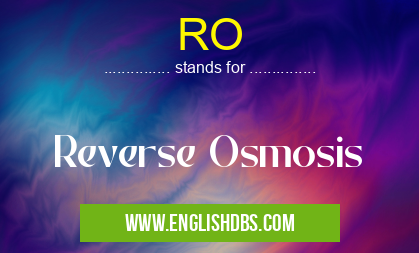What does RO mean in ACADEMIC & SCIENCE
RO (Reverse Osmosis) is a water purification technology that uses a semipermeable membrane to remove impurities, dissolved solids, and other contaminants from water. It is commonly used in both residential and commercial settings to improve the quality of drinking water and for various industrial applications.

RO meaning in Academic & Science in Academic & Science
RO mostly used in an acronym Academic & Science in Category Academic & Science that means Reverse Osmosis
Shorthand: RO,
Full Form: Reverse Osmosis
For more information of "Reverse Osmosis", see the section below.
How Reverse Osmosis Works
Reverse osmosis involves forcing water through a thin, semipermeable membrane that allows water molecules to pass through while blocking larger molecules, ions, and other contaminants. The membrane creates a barrier, separating the purified water from the contaminants, which are flushed away as wastewater.
Benefits of Reverse Osmosis
-
Removes Impurities: RO effectively removes a wide range of impurities, including:
- Bacteria
- Viruses
- Heavy metals
- Dissolved solids
- Chemicals and pesticides
-
Improves Taste and Odor: RO removes impurities that can affect the taste and odor of water, resulting in cleaner, more palatable drinking water.
-
Reduces Health Risks: By removing contaminants, RO helps reduce the risk of waterborne illnesses and other health concerns associated with poor water quality.
-
Industrial Applications: RO is widely used in industrial processes, such as:
- Desalination
- Food and beverage production
- Pharmaceutical manufacturing
Drawbacks of Reverse Osmosis
-
Cost: RO systems can be more expensive to purchase and maintain than other water purification methods.
-
Wastewater Generation: RO produces a significant amount of wastewater, which needs to be properly disposed of.
-
Mineral Removal: RO can remove beneficial minerals from water, potentially reducing its nutritional value.
Essential Questions and Answers on Reverse Osmosis in "SCIENCE»SCIENCE"
What is Reverse Osmosis (RO)?
Reverse Osmosis (RO) is a water purification technology that uses a semipermeable membrane to remove impurities, including ions, molecules, and larger particles, from water.
How does RO work?
RO uses a semipermeable membrane that allows water molecules to pass through while blocking larger particles. The water is forced through the membrane by applying pressure, leaving the impurities behind.
What types of impurities does RO remove?
RO removes a wide range of impurities, including:
- Dissolved salts (e.g., calcium, magnesium, sodium, chloride)
- Heavy metals (e.g., lead, mercury, arsenic)
- Organic compounds (e.g., pesticides, herbicides, pharmaceuticals)
- Viruses and bacteria
Is RO water safe to drink?
Yes, RO water is generally considered safe to drink. It has been purified to remove most harmful contaminants and meets drinking water standards. However, RO water may sometimes be slightly acidic and should not be stored for extended periods.
What are the benefits of using RO water?
RO water offers several benefits, including:
- Improved taste and odor
- Reduced risk of waterborne illnesses
- Removal of harmful contaminants
- Potential health benefits, such as lower blood pressure and improved heart health (research is ongoing)
What are the drawbacks of using RO water?
RO water also has some drawbacks, including:
- Can be expensive to install and maintain
- May remove beneficial minerals from water
- Can produce wastewater that needs to be disposed of properly
Is RO water the best option for everyone?
Whether RO water is the best option for you depends on your individual needs and circumstances. If you have access to safe drinking water, RO may not be necessary. However, if you are concerned about water quality or have specific health concerns, RO can provide a high level of purification.
Final Words: Reverse Osmosis is an effective water purification technology that can significantly improve the quality of drinking water and remove harmful contaminants. However, it is important to consider the costs, wastewater generation, and mineral removal before choosing RO as a water purification method.
RO also stands for: |
|
| All stands for RO |
